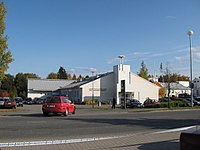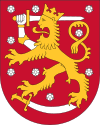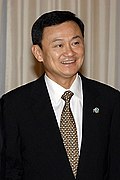| This Wikipedia page has been superseded by Portal:Finland and is retained primarily for historical reference. |
| Note: Article entries are now being transcluded directly on the main portal page. However, this page should be retained for historical reference. |
Selected article 1
Portal:Finland/Selected article/1

Turku (Finnish: [ˈturku] ⓘ; Swedish: Åbo [ˈoːbu] ⓘ) is a city in Finland, founded in the 13th century. Turku is the fifth largest city in Finland, with a population of 175 286 (2007), and is located in the south-west of the country at the mouth of the Aura river. It is the capital city of both the region of Finland Proper and the province of Western Finland, as well as being the centre of the country's third largest urban area with over 300,000 inhabitants.
Turku is the former capital and oldest city in Finland, having been founded on an as yet undetermined date during the late 13th century. It has a long history as the country's largest city and administrative centre, but has during the last two centuries lost that status to Helsinki. As a remnant of its long history, the city hosts a number of important historical landmarks, such as the Turku Castle and the Cathedral of Turku.
Due to the city's location, the sea is also an important part of its history and present. Today the Port of Turku is possibly the most important seaport in the whole of Finland.
Selected article 2
Portal:Finland/Selected article/2

The Finnish Civil War was a part of the national and social turmoil caused by World War I in Europe. The war was fought from January 27, 1918 to May 15, 1918, between the forces called the "Reds" led by the People's Deputation of Finland under the control of the Finnish Social Democrats, and the forces called the "Whites", led by the Senate of Vaasa representing the Senate of Finland formed by the bourgeois parties. The defeat in World War I and the February and October revolutions in 1917 caused a total collapse of the Russian Empire; and the destruction of the mother country resulted in a corresponding breakdown of Finnish society during 1917. As there were no generally accepted police and army forces to keep order in Finland after March 1917, the left and right began building security groups of their own, leading to the emergence of two independent armed military troops, the White and Red Guards. The Whites were the victors in the war that followed. The Civil War remains the most controversial and emotionally loaded event in the history of modern Finland. Approximately 37,000 people died during the conflict, including casualties at the war fronts, and deaths from political terror campaigns and high prison camp mortality. The turmoil destroyed the economy, split the political apparatus, and divided the Finnish nation for many years. (more...)
Selected article 3
Portal:Finland/Selected article/3

The Kauhajoki school shooting was a school shooting that occurred on 23 September 2008, at Seinäjoki University of Applied Sciences in Kauhajoki, a city in Western Finland. The gunman, 22-year-old culinary arts student Matti Juhani Saari, shot and fatally injured ten people with a semi-automatic pistol, before shooting himself in the head. He died a few hours later in Tampere University Hospital. One woman was injured but was in a stable condition.
The shooting took place at the Kauhajoki School of Hospitality, owned by the Seinäjoki Municipal Federation of Education. The facilities and campus were shared between the Seinäjoki University of Applied Sciences and the Seinäjoki Vocational Education Centre - Sedu. Saari was a second-year student in a Bachelor of Hospitality Management degree programme.
The incident was the second school shooting in less than a year in Finland, the other being the Jokela school shooting in November 2007, in which nine people including the gunman were killed. Before that, only one other school shooting had taken place in the country's history, in Rauma in 1989, leaving two people dead.
Selected article 4
Portal:Finland/Selected article/4

Gyromitra esculenta is an ascomycete fungus from the genus Gyromitra, widely distributed across Europe and North America and one of several species of fungi known as false morels. It normally sprouts in sandy soils under coniferous trees, in spring and early summer. The fruiting body, or mushroom, is an irregular brain-shaped cap dark brown in colour which can reach 10 cm (4 in) high and 15 cm (6 in) wide, perched on a stout white stipe up to 6 cm (2.4 in) high. Although potentially fatal if eaten raw, Gyromitra esculenta is a popular delicacy in Scandinavia, Eastern Europe, and the upper Great Lakes region of North America. It may be sold fresh in Finland, but it must be accompanied by warnings and instructions on correct preparation. It is eaten in omelettes, soups, or sautéed in Finnish cuisine. Once popular in the Pyrenees, it is now prohibited from sale for consumption in Spain. Although it is still commonly consumed after parboiling, recent evidence suggests that even this procedure may not make the fungus entirely safe; thus raising concerns of risk even when prepared properly. When consumed, the false morel's principal active agent, gyromitrin, is metabolized into the toxic compound monomethylhydrazine. The toxin affects the liver, central nervous system, and sometimes the kidneys. (more...)
Selected article 5
Portal:Finland/Selected article/5

Personent hodie is a Christmas carol originally published in the 1582 Finnish song book Piae Cantiones, a volume of 74 Medieval songs with Latin texts collected by Jaakko Suomalainen, a Swedish Lutheran cleric, and published by T.P. Rutha. The song book had its origins in the libraries of cathedral song schools, whose repertory had strong links with medieval Prague, where clerical students from Finland and Sweden had studied for generations. A melody found in a 1360 manuscript from the nearby Bavarian city of Moosburg in Germany is highly similar, and it is from this manuscript that the song is usually dated.
Selected article 6
Portal:Finland/Selected article/6

Helsinki (in Finnish; ⓘ), or Helsingfors (in Swedish; ⓘ) is the capital and largest city of Finland. It is in the southern part of Finland, on the shore of the Gulf of Finland, by the Baltic Sea. The population of the city of Helsinki is 569,892 (2008), making it the most populous municipality in Finland by a wide margin. The foreign-born population stands at around 10%.
Helsinki, along with the neighbouring cities of Vantaa, Espoo, and Kauniainen, constitutes what is known as the capital region, with over 1,000,000 inhabitants. The Greater Helsinki area contains 12 municipalities and has a population of over 1,300,000. The Greater Helsinki accounts for a quarter of the population of Finland, 29% of jobs, and a third of the GDP.
Helsinki is Finland's capital for business, education, research, culture, and government. Greater Helsinki has eight universities and six technology parks. Some 70% of foreign companies operating in Finland have settled in the Helsinki region. The immigration of rural residents has made it one of the fastest growing metropolitan areas in Europe.
Finland's main international airline hub, Helsinki-Vantaa airport is 40 minutes from the city center, with direct flights around the world. The busy Helsinki-Tallinn route takes 1.5 hours by sea and 18 minutes by helicopter. Two other big cities in Finland, Tampere and Turku, can be reached in 1.5 - 2 hours by train and 1.5 - 2.5 hours by car.
Selected article 7
Portal:Finland/Selected article/7

Tampere (Finnish: [ˈtɑmpere] ⓘ; Swedish: Tammerfors [tɑmːærˈforsː] ⓘ) is a city in southern Finland located between two lakes, Näsijärvi and Pyhäjärvi. Since the two lakes differ in level by 18 metres, the rapids linking them, Tammerkoski, has been an important power source throughout history, most recently for generating electricity. Tampere is dubbed the "Manchester of Finland" for its industrial past.
The Tampere region, or Pirkanmaa, which includes outlying municipalities, has around 470,000 residents, 230,000 employed, and 25 billion euro turnover as of 2007.
Tampere is the most populous inland city in any of the Nordic countries. The city has a population of 209,000, and Tampere's metropolitan area has a population of over 340,000. Tampere is the third most-populous municipality in Finland, after the Greater Helsinki municipalities of Helsinki and Espoo. Helsinki can be reached in 1.5 - 2 hours by train and 2 - 2.5 hours by car. The distance to Turku is approximately the same. Tampere airport is the second busiest international airport in Finland with 800,000 passengers annually.
Selected article 8
Portal:Finland/Selected article/8

Finnish (ⓘ, or suomen kieli) is the language spoken by the majority of the population in Finland (92% as of 2006[update]) and by ethnic Finns outside of Finland. It is one of the two official languages of Finland and an official minority language in Sweden. In Sweden, both standard Finnish and Meänkieli, a Finnish dialect, are spoken. The Kven language, which is closely related to Finnish, is an official minority language in Norway.
Finnish is a member of the Finno-Ugric language family and is typologically between fusional and agglutinative languages. It modifies and inflects the forms of nouns, adjectives, pronouns, numerals and verbs, depending on their roles in the sentence.
Selected article 9
Portal:Finland/Selected article/9

The Flag of Finland (Finnish: Suomen lippu, Swedish: Finlands flagga), also called Siniristilippu ("Blue Cross Flag"), dates from the beginning of the 20th century. It features a blue Nordic cross on a white background. Blue represents lakes and the sky, and white represents snow and the white nights of the Finnish summer. The state flag has a coat of arms in the centre, but is otherwise identical to the civil flag. The swallow-tailed state flag is used by the military. The presidential standard is identical to the swallow-tailed state flag but also has in its upper left corner the Cross of Liberty after the Order of the Cross of Liberty, which has the President of Finland as its Grand Master. Like Sweden's, Finland's national flag is based on the Scandinavian cross. It was adopted after independence from Russia, when many patriotic Finns wanted a special flag for their country, but its design dates back to the 19th century. The blue coloring is said to represent the country's thousands of lakes and the sky, with white for the snow that covers the land in winter. This color combination has also been used over the centuries in various Finnish provincial, military, and town flags.
Selected article 10
Portal:Finland/Selected article/10

The Coat of Arms of Finland were granted at the burial of Gustav Vasa in 1560 and still remain the arms of the Republic of Finland. The arms were also used as the official symbol of the Grand Duchy of Finland.
The blazon as described in the act on the arms of Finland (381/78) may be translated as follows: "Gules, among nine roses argent, a lion rampant crowned Or, having for its dexter forepaw a human arm armoured, brandishing a sword and in base a falchion fesswise reversed, both of the second hilted of the third."
Selected article 11
Portal:Finland/Selected article/11

Our Land, Maamme (Finnish), or Vårt land (Swedish), is the title of Finland's national anthem. Finnish law doesn't state anything about a national anthem so the song has an unofficial status.
The music was composed by the German immigrant Fredrik Pacius, with (original Swedish) words by Johan Ludvig Runeberg, and was performed for the first time on 13 May 1848. The original poem, written in 1846 but not printed until 1848, had 11 stanzas and formed the prologue to the great verse cycle The Tales of Ensign Stål ("Fänrik Ståhls Sägner"), a masterpiece of Romantic nationalism. The current Finnish text is usually attributed to the 1889 translation of Ensign Stål by Paavo Cajander, but in fact originates from the 1867 translation by Julius Krohn.
The Tales of Ensign Stål were much appreciated throughout all of Scandinavia. Up until the time of Finland's independence in 1917–18, when the song began to be recognized as specifically applying to Finland, Pacius's tune and Runeberg's text were often also sung in Denmark, Norway, and Sweden. Note that in the original Swedish text there is no reference to Finland (except for in verses 4 and 10, which are rarely sung), only to a country in the north, but the Finnish text explicitly refers to Finland. The poem's theme is, furthermore, remarkably similar to that of the national anthems of Sweden (Du gamla, Du fria) and Norway (Ja, vi elsker dette landet).
Some Finns have proposed that the Finnish national anthem be changed to Finlandia by Jean Sibelius, with lyrics by V.A. Koskenniemi (Finnish) and Joel Rundt (Swedish). It is also said that Pacius composed the tune in a mere fifteen minutes, with no idea that it would become so important to the people of Finland that they would eventually make it their national anthem. There are also those who simply prefer Finlandia as a musical piece, although critics call it difficult to sing.
The tune of Maamme has similarities with the German drinking song Papst und Sultan. Many believe that Fredrik Pacius intentionally or unintentionally copied parts of the tune. Another Finnish patriotic song, Sotilaspoika, composed by Pacius, also includes similarities with Papst und Sultan.
The melody of Maamme is also used for the national anthem of Estonia with a similarly themed text, Mu isamaa, mu õnn ja rõõm, My Fatherland, My Happiness and Joy (1869).
Selected article 12
Portal:Finland/Selected article/12

The Finland Plot, Finland Plan, Finland Strategy or Finland Declaration (Thai: แผนฟินแลนด์, ยุทธศาสตร์ฟินแลนด์, ปฏิญญาฟินแลนด์) are names of a controversial agenda espoused by Sondhi Limthongkul and supporters affiliated with the People's Alliance for Democracy (PAD) in May 2006 describing a plot allegedly developed by Thai Prime Minister Thaksin Shinawatra and former Thai communist Party members to make a regime change; the royal power severed or restrained, one-party system, authoritarian rule by one party. The 'plot' allegedly was planned in Finland in 1999 during Thaksin's visit. However Thaksin admitted that he and his team were on vacation trip in Finland in 1997.
The allegations had a negative impact on the popularity of Thaksin and his government, despite the fact that no evidence was ever produced to verify the existence of a plot. Thaksin and his Thai Rak Thai party vehemently denied the accusations and sued the accusers. Thaksin's supporters blasted it as a propaganda to topple the premier's rule.
Selected article 13
Portal:Finland/Selected article/13

Tarja Kaarina Halonen (pronounced ⓘ) (born 24 December 1943) is a former President of Finland. She began her first six-year term of office in 2000 and was re-elected on January 29, 2006. Her term expired in 2012. She was the first woman to hold the office.
President Halonen is a member of the Council of Women World Leaders, an International network of current and former women presidents and prime ministers whose mission is to mobilize the highest-level women leaders globally for collective action on issues of critical importance to women and equitable development.
Selected article 14
Portal:Finland/Selected article/14 Max Payne 2: The Fall of Max Payne is a third-person shooter video game developed by the Finnish Remedy Entertainment and produced by 3D Realms. The game is a direct sequel to the 2001 video game Max Payne. It was released by Rockstar Games for Windows on October 15, 2003, for Xbox on November 25, 2003, and for PlayStation 2 on December 2, 2003. In Max Payne 2, the player controls Max, a detective for the New York City Police Department (NYPD). In the game's predecessor, Max Payne, the developers played all the roles, except for Max. In Max Payne 2, however, professional actors were used to model and voice all the characters.
Max Payne 2 continues the story of Max Payne, who was a fugitive undercover cop framed for murder in New York City at the end of Max Payne. Two years after the events of the first game, Max has cleared his name and is now an NYPD detective. He reunites with Mona Sax, whom he first met in the previous game. Max meets his new NYPD partner, Valerie Winterson, who later tries to kill Mona because she is a fugitive and had stumbled upon secrets that were not meant for her to know. However, Max kills Winterson first, and he and Mona set out to resolve a conspiracy of death and betrayal, finding the mysterious Inner Circle in the center of it all.
Video game critics gave Max Payne 2 generally favorable reviews. Praise focused on its action and story, while criticism targeted its short length. Despite the positive reception, the game sold poorly, leading Rockstar Games' parent company Take-Two Interactive to cite Max Payne 2's sales as a cause for the company's reforecasted finances of 2004. Max Payne 2 received several industry awards, including Outstanding Art Direction at the Golden Satellite Awards 2004, and Editors' Choice Awards from GamePro, IGN, and GameSpy.